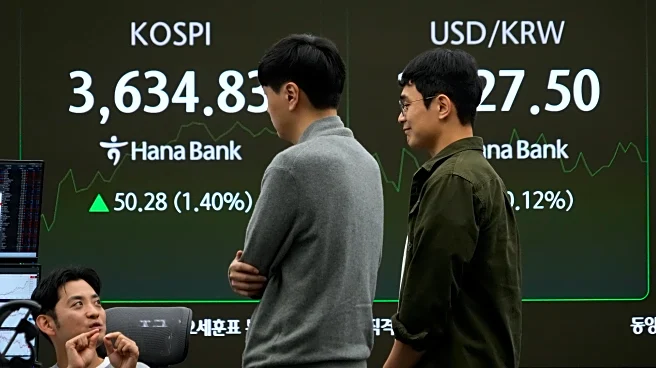What's Happening?
The U.S. stock market experienced significant fluctuations as trade tensions between the United States and China continued to escalate. The Standard & Poor’s 500 index closed 0.2% lower, while the Dow Jones Industrial Average rose 0.4%, and the Nasdaq composite dropped 0.8%. These movements reflect ongoing volatility driven by shifting trade sentiments between Washington and Beijing. Recently, China’s Commerce Ministry banned dealings by Chinese companies with five subsidiaries of South Korean shipbuilder Hanwha Ocean, impacting President Trump’s efforts to revitalize the American shipbuilding industry. Technology stocks, particularly sensitive to trade issues with China, were among the biggest weights on the market, with companies like Nvidia and Broadcom experiencing declines.
Why It's Important?
The trade conflict between the U.S. and China is significant due to the size and influence of both economies. The ongoing tensions have created uncertainty in the stock market, affecting investor confidence and potentially impacting economic growth. Technology companies, which rely heavily on China for raw materials and manufacturing, are particularly vulnerable. The situation could lead to increased costs for consumers if retaliatory tariffs are imposed. Additionally, the U.S. government shutdown has halted economic updates, complicating efforts to assess the impact of tariffs. The Federal Reserve is also affected, lacking data to make informed policy decisions, which could influence interest rates and economic stability.
What's Next?
The Federal Reserve is expected to continue monitoring the situation closely, with potential interest rate cuts anticipated in upcoming meetings. Investors are looking to company earnings reports for insights into the broader economic picture. The lack of economic data due to the government shutdown may lead to increased market volatility. Both the U.S. and China may seek a negotiated resolution to avoid further economic consequences, given the significant stakes involved. The ongoing trade tensions could lead to more strategic shifts in global supply chains and manufacturing practices.
Beyond the Headlines
The trade tensions highlight the complex interdependencies between the U.S. and Chinese economies, particularly in technology and manufacturing sectors. The situation underscores the geopolitical dimensions of economic policies and their impact on global markets. Long-term shifts may include changes in trade agreements and increased efforts by countries to diversify supply chains to reduce reliance on any single nation.












